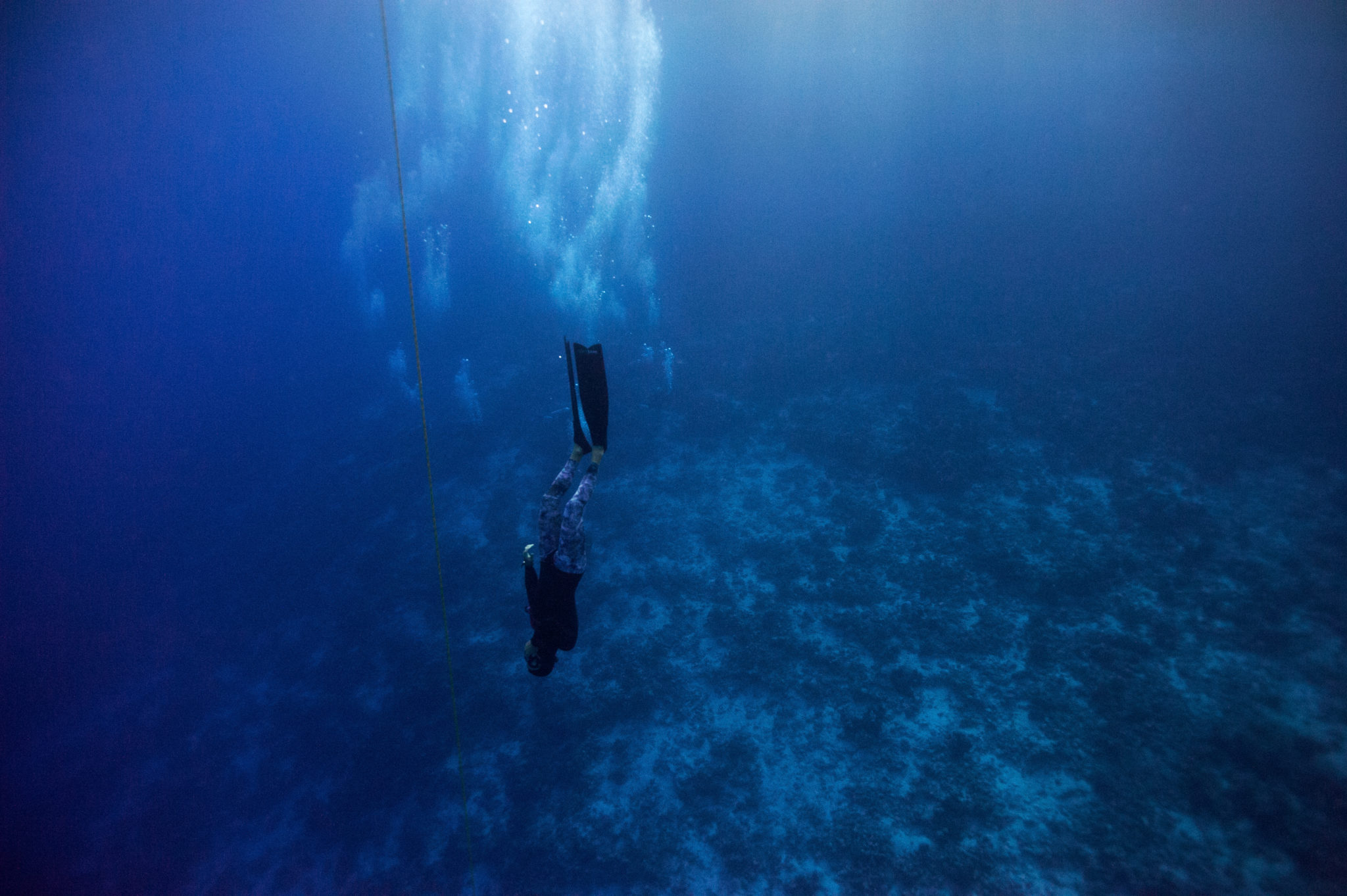Underwater breathing extends to mental relaxation, teaching us the true meaning of calm during freediving.
As I slowly pull myself hand over hand along a weighted line into the depths of the sea, I fight to ignore the pressure building in my ears, and the spasm rising in my diaphragm that is signaling my body to breathe. Rays of sunlight spike through the ocean, spotlighting my final destination: a sunken ship 97 feet below. I try to let the soft serenades of humpback whales lull me into a Zen-like trance as I repeat the mantra, “Just relax,” in my head.
But all I can think about is breathing. When I look upward, the sight of the ocean’s surface triggers a panic. I kick my fins urgently until I pop above water. My freediving instructor, Benjamin Zyons, leads me through six deep exhalations, known as purge breaths, to help clear the carbon dioxide that has built up in my body. I give him the signal that I’m OK, aware that 90 percent of freediving blackouts occur after surfacing. Then I remove my mask and sheepishly acknowledge my freak-out.
Freediving, despite popular belief, isn’t about holding your breath, as much as it is about learning to stay calm in discomfort. Zyons, the founder and lead instructor of Maui-based Freedive Hawaii, describes the sport as “underwater meditation.” He moved from Rhode Island to Hawai‘i in 2004 for the surfing, and then discovered freediving.
“Growing up, I’d dive near the shore for mussels and lobster, but I had no idea that freediving was its own sport and that the body could sustain depths of 200-plus feet,” he says. He spent eight years honing his skills and, in 2014, launched Freedive Hawaii.


I grew up in the ocean, so I had assumed I’d be a natural at freediving. But I quickly realize I need to retrain my brain if I want to safely reach depths of 100-plus feet. In order to hold my breath underwater, I first must relearn to breathe on land. A few weeks after my first dive attempt, I sign up for a land-based workshop with Zyons at Lumeria, a wellness retreat in Upcountry Maui.
Here, Zyons, a certified yoga instructor, leads me and four others in the class through a series of breathing exercises. Anyone can learn to freedive, Zyons says to me, assuring “all humans have a mammalian diving reflex.” When this physiological reaction kicks in, the heart slows, peripheral blood vessels constrict, and the spleen compresses to dope the body with red blood cells. These reactions, Zyons explains, help to reduce the consumption of oxygen, while continuing to provide sufficient quantities to vital organs.
We lie on the ground in the shade of pine trees, our hands on our bellies and eyes closed, as Zyons instructs us to let the stomach expand. We inhale deeply, stretching the chest’s intercostal muscles to maximize the space for the lungs, then sip in still a bit more air.
Two muscle groups are involved in breathing: the diaphragm, which is right below the lungs, and the intercostal muscles, which help the chest and rib cage contract and expand. If we are belly breathing correctly, our bellies should be expanding and deflating like a balloon. Chest breathing, Zyons explains, increases the feeling of anxiety.
Next, Zyons has us partner up (rule no. 1: never dive alone) before moving to Lumeria’s pool to practice static apnea exercises, basically the dead man’s float. My partner effortlessly pulls off a two-minute hold on her first attempt. I follow, and barely keep my face in the water for 30 seconds. Despite the buoyancy of my wetsuit, Zyons can see my body is tensed: My elbows are locked, neck strained. “Relax,” he urges.
I try again, this time closing my eyes and imagining the beach. I feel a jolt of pressure in my diaphragm, but when my partner taps my shoulder to see if I’m OK, I signal with my finger that I can stay down. “You need to decipher between what you think is the urge to breathe versus what is the real need to breathe,” Zyons says. This time, I last a minute and a half, and when I surface, I’m not gasping for air.
After the course, I embrace a daily breathing practice. A few weeks later, I’m ready to reattempt my ocean dive, this time to the Carthaginian, a sunken ship that sits about a half-mile offshore from Puamana Beach Park. During the journey there on my stand-up paddleboard, I calm my breath and mind.
This time, Zyons dives down alongside me. I equalize my ears and feel my heartbeat slow. After a few seconds, my body begins to ignore the urge to breathe, my mind quiets, and my muscles relax. Then, for the first time, I feel complete serenity under the sea.


JUST BREATHE
Are you a belly breather or chest breather? This breathing exercise hones proper diaphragmatic breathing to help retain one’s breathe longer underwater, but the same principles can be applied to relaxing your breathing on land.


one Lie on your back with a rolled towel under your head. Place a lightweight object on your stomach.
two Close your eyes and imagine a string attached to your naval being pulled straight up and down as you inhale and exhale. Feel the object rise and fall with each breath.
three On your inhale, fill your stomach with air, so you have a potbelly. Pause at the top of the inhale. Slowly exhale, drawing the stomach inward as the air escapes from the lungs comfortably, like air releasing from a pinched balloon. Pause at the bottom of the exhale.
four Repeat until a state of complete relaxation is achieved.

